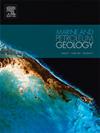The deep roots and emplacement of Santonian intrusions in the Pre-Salt reservoirs of the Mero Field, Santos Basin, Brazil
IF 3.7
2区 地球科学
Q1 GEOSCIENCES, MULTIDISCIPLINARY
引用次数: 0
Abstract
The carbonate reservoirs of the Mero field in the Santos Basin were intruded during the Upper Cretaceous by a series of alkaline basalt composition diabase dikes and sills. Despite the field's significance as one of Brazil's leading oil producers, the roots, migration, evolution, and emplacement mechanisms of this magmas in the reservoirs remain poorly understood. This study aims to contribute to the understanding of this phenomenon by presenting novel results based on seismic analysis and the only available core samples of two diabase intrusions from this event and their respective carbonate reservoir host rocks in Mero field. The two sills sampled by well 3-BRSA-1322-RJS are emplaced at the top of the Barra Velha Formation and represent segments of the same sheet intrusion. The roots of these intrusive bodies are associated with a complex plumbing system concentrated within lithospheric discontinuities, specifically the Mohorovičić (Moho). The NNW-SSE orientation of the studied sheet intrusion and of some of the underlying dikes indicate a structural control by deep basement faults with the same orientation, reactivated during the rifting phase and Upper Cretaceous. The emplacement mechanism of the sheet intrusion within the reservoir carbonates appears to be controlled by stratigraphic factors. The magma preferentially intrudes the rudstone/laminite contacts and laminite layers of the Lula's Fingers stratigraphic marker (LFSM). The high-temperature of this igneous body (1088–1158 °C) induced the cracking of organic matter within the host rock, leading to the production of liquid and gaseous hydrocarbons. Localized fractures within the diabases filled with bitumen indicate also the presence of hydrocarbon storage within these rocks. The segmentation of the sheet intrusion within laminite is attributed to the fissility of this rock and the formation of fractures in the magmatic front during the rapid maturation of organic matter. The mushroom-like morphology of the intrusion reflects the lateral migration of magma along the LFSM that cover a carbonate high (mound) in the NE of Mero Field. The segmentation of this intrusive body locally compartmentalizes the reservoir of the Mero field into "box-work" blocks impacting their connectivity. Geochemical evidence and textural features indicate that the sill was replenished by multiple pulses of alkaline basaltic melt from the same magma reservoir. The emplaced magma evolved through fractional crystallization, resulting in the formation of net-veined complexes composed of residual trachytic materials. The high concentrations of anorthoclase in these magmatic residues result in a positive peak in the gamma-ray log along the intrusions. The findings presented in this study elucidate the intricate evolution of these magmas from their ascent to their emplacement in the pre-salt carbonates. Additionally, they offer novel perspectives on the potential impacts of these magmas on the host rocks and their implications for the petroleum system of the Mero Field.

求助全文
约1分钟内获得全文
求助全文
来源期刊

Marine and Petroleum Geology
地学-地球科学综合
CiteScore
8.80
自引率
14.30%
发文量
475
审稿时长
63 days
期刊介绍:
Marine and Petroleum Geology is the pre-eminent international forum for the exchange of multidisciplinary concepts, interpretations and techniques for all concerned with marine and petroleum geology in industry, government and academia. Rapid bimonthly publication allows early communications of papers or short communications to the geoscience community.
Marine and Petroleum Geology is essential reading for geologists, geophysicists and explorationists in industry, government and academia working in the following areas: marine geology; basin analysis and evaluation; organic geochemistry; reserve/resource estimation; seismic stratigraphy; thermal models of basic evolution; sedimentary geology; continental margins; geophysical interpretation; structural geology/tectonics; formation evaluation techniques; well logging.
 求助内容:
求助内容: 应助结果提醒方式:
应助结果提醒方式:


